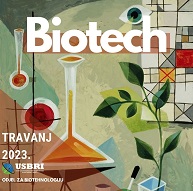Novosti iz biotehnologije
Genetically modified foods, who has to tell?
Consumers who believe they have a "right to know" whether their food contains genetically modified ingredients are pressing lawmakers, regulators and voters to require labels on altered foods. But even if they succeed, experts say there's no guarantee that labels identifying genetically engineered foods would ever appear on packages. Ads by Google Domed Labels, Namplates - 3d Domed labels, Digital printing Aluminium, Etched S/Steel & Brass - www.mockridge.com "People are usually surprised to learn that there is no legal right to know," said Michael Rodemeyer, an expert on biotechnology policy at the University of Virginia in Charlottesville. A variety of rules and regulations control the words that appear on food packages. Such rules must be balanced against companies' constitutionally protected right of commercial speech, experts said. "It's an unsettled area in the law," said Hank Greely, director of the Stanford Center for Law and the Biosciences in Palo Alto. "If I were a betting man, I think the odds are good that the Supreme Court would ... strike down a GMO labeling requirement." Consumers do have the right to know some things about foods, and it's the job of the Food and Drug Administration to enforce the various rules. Labels must carry an accurate name for the food, as well as its weight and manufacturer, a list of ingredients and, since 1990, that panel of calories and breakdown of basic nutrients that some people pore over and others blithely ignore. And labels cannot be false or misleading. Consumers have a right to know that a foodstuff contains the nutrients they'd reasonably expect to find in a food with that name: An orange lacking vitamin C (should anyone desire to create such a thing) would have to be labeled as such. They also have the right to know if a food contains something new that makes it materially different, such as an allergen or unexpected nutrient. Soybean varieties that are genetically engineered to contain high amounts of the monounsaturated fat oleic acid must bear labels that make that property clear, said FDA spokesperson Morgan Liscinsky. But there is no requirement that food producers use those labels to say how they raised those oleic acid levels, according to the FDA. They could have done it through conventional breeding or by irradiating plant tissue to create mutations or by fusing cells together in a dish - or with genetic engineering. (February 27, 2013 by RosieMestel)
In Treating Cognitive Decline, Timing Is Crucial
Scientists working at the Mayo Clinic say they have modeled the temporal accumulation of Beta amyloid plaques in the brain linked to decline in memory and thinking abilities. The study appeared in the online edition of Neurology on February 27th. Knowledge of the temporal pattern of plaque deposition, could, the Mayo scientists said, identify the optimal time during the course of its accumulation that therapeutic intervention might prove most effective. In their study, plaque accumulation over time was assessed using serial amyloid position emission tomography (PET) imaging to test individuals, aged 70–92, who were enrolled in either the Mayo Clinic Study of Aging or the Mayo Alzheimer’s Disease Research Center. Study participants included 205 individuals classified as cognitively normal and 55 as cognitively impaired (47 mild cognitive impairment and 8 Alzheimer’s dementia). All underwent two or more serial amyloid PET. The investigators measured baseline amyloid PET relative standardized uptake values (SUVR) and, for each participant, estimated a slope representing each patient’s annual amyloid accumulation rate. The data implied a roughly 15-year interval from an SUVR of 1.5 to 2.5. This period during which the slope of the amyloid SUVR vs. time curve is greatest and roughly linear represents, they said, a large therapeutic window for secondary preventative interventions. The study found that the rate of buildup accelerates initially, and then slows before plateauing at high levels. The rate of plaque accumulation was highest in those with mid-range levels at the start of the study. Those with low levels or high levels of the plaques as the study began had lower rates of plaque buildup.
The authors said their data implied that therapeutic interventions designed to reduce the rate of new amyloid deposition (noting the distinction from removing previously deposited amyloid) may be less effective in patients who have already reached plateau levels of amyloid deposition. Lead study author Clifford Jack, Jr., M.D., a Mayo clinic radiologist and the Alexander Family Professor of Alzheimer’s Disease Research at Mayo, said that the study supports the role that plaque formation in the brain plays in a decline in memory and thinking abilities, and takes about 15 years to build up and then plateau. “Our results suggest that there is a long treatment window where medications may be able to help slow buildup of the amyloid plaques that are linked to cognitive decline,” he noted. “On the other hand, trying to treat the plaque buildup after the amyloid plaque load has plateaued may not do much good.” Interestingly, the study also found that the rate of buildup of plaques was more closely tied to the total amount of amyloid plaques in the brain than other risk factors, including level of cognitive impairment, age, and the presence of the APOE gene, a gene linked to Alzheimer's disease. (GEN, Feb. 27. 2013.)
Research Could Lead to a Better Understanding of Flesh-Eating Disease
Sep. 28, 2012— Royal Society University Research Fellow Dr Edward Taylor, from the University of Lincoln's School of Life Sciences, is carrying out research on bacteriophage that play a role in flesh-eating disease. Dr Taylor spent the last ten years at the University of York where he was awarded a Royal Society University Research Fellowship in 2006. He has chosen to continue his research at the University of Lincoln, with funding continuing for a further two years. Bacteriophage (often called phage) are viruses that infect bacteria. These are extremely common and mostly harmless; however some play a role in diseases such as diphtheria, cholera, dysentery, botulism, necrotizing (flesh-eating) pneumonia, toxic shock and scarlet fever. Phages are nature's "genetic engineers," frequently swapping genes between bacterial strains. This happens by the phage attaching itself to the surface of the cell, making a hole and then injecting its own DNA into the bacteria. Occasionally this DNA becomes integrated into the bacterial chromosome where it lays dormant, but more commonly the phage is active straight away. The bacterial metabolism is hijacked, the DNA de-coded and new phages are produced in great numbers. Finally the bacterium is burst open and the new virus particles escape.
This inactive/active life style allows the phage to cleverly separate its outbreaks over long periods of time. Some phage which infect harmful bacteria carry toxin and other genes which when decoded interact with our immune systems, tying them together, giving the phage and bacteria a better chance of survival. Some phages also destroy bacteria.Dr Taylor works on a particular phage which infects a flesh-eating bacterium called 'Streptococcus pyogens'. This carries a toxin and DNase genes, which when expressed go on to damage the immune system causing scarlet fever, "toxic shock" and more invasive necrotizing forms of infection. Dr Taylor said: "This research will allow for a fundamental understanding of bacterial pathogenicity and the role of viruses in disease processes. The overall aim is to carry out an in-depth structural study on one phage that prompts Streptococci to become toxigenic. I am studying complexes of the viral proteins using a technique -- known as X-ray crystallography. This enables me to "see" the individual atoms within a protein. I am particularly interested in the mechanism of enzymes which break down DNA. These have been shown to help the Streptococcus pyogenes evade capture by the immune system and promote more invasive necrotizing forms of infection. I am studying these enzymes by making small changes to the protein structure and seeing what effect this has on the way the enzyme works. Through these changes I hope to gain a better understanding of the disease process." . (Science News, 27.02. 2013).
Viruses Can Have Immune Systems: A Pirate Phage Commandeers the Immune System of Bacteria
A study published in the journal Nature reports that a viral predator of the cholera bacteria has stolen the functional immune system of bacteria and is using it against its bacterial host. The study provides the first evidence that this type of virus, the bacteriophage ("phage" for short), can acquire a wholly functional and adaptive immune system. The phage used the stolen immune system to disable -- and thus overcome -- the cholera bacteria's defense system against phages. Therefore, the phage can kill the cholera bacteria and multiply to produce more phage offspring, which can then kill more cholera bacteria. The study has dramatic implications for phage therapy, which is the use of phages to treat bacterial diseases. Developing phage therapy is particularly important because some bacteria, called superbugs, are resistant to most or all current antibiotics.
Until now, scientists thought phages existed only as primitive particles of DNA or RNA and therefore lacked the sophistication of an adaptive immune system, which is a system that can respond rapidly to a nearly infinite variety of new challenges. Phages are viruses that prey exclusively on bacteria and each phage is parasitically mated to a specific type of bacteria. This study focused on a phage that attacks Vibrio cholerae, the bacterium responsible for cholera epidemics in humans.Howard Hughes Medical Institute investigator Andrew Camilli, Ph.D., of Tufts University School of Medicine led the research team responsible for the surprising discovery.First author Kimberley D. Seed, Ph.D., a postdoctoral fellow in Camilli's lab, was analyzing DNA sequences of phages taken from stool samples from patients with cholera in Bangladesh when she identified genes for a functional immune system previously found only in some bacteria (and most Archaea, a separate domain of single-celled microorganisms).
To verify the findings, the researchers used phage lacking the adaptive immune system to infect a new strain of cholera bacteria that is naturally resistant to the phage. The phage were unable to adapt to and kill the cholera strain. They next infected the same strain of cholera bacteria with phage harboring the immune system, and observed that the phage rapidly adapted and thus gained the ability to kill the cholera bacteria. This work demonstrates that the immune system harbored by the phage is fully functional and adaptive.
"Virtually all bacteria can be infected by phages. About half of the world's known bacteria have this adaptive immune system, called CRISPR/Cas, which is used primarily to provide immunity against phages. Although this immune system was commandeered by the phage, its origin remains unknown because the cholera bacterium itself currently lacks this system. What is really remarkable is that the immune system is being used by the phage to adapt to and overcome the defense systems of the cholera bacteria. Finding a CRISPR/Cas system in a phage shows that there is gene flow between the phage and bacteria even for something as large and complex as the genes for an adaptive immune system," said Seed.
"The study lends credence to the controversial idea that viruses are living creatures, and bolsters the possibility of using phage therapy to treat bacterial infections, especially those that are resistant to antibiotic treatment," said Camilli, professor of Molecular Biology & Microbiology at Tufts University School of Medicine and member of the Molecular Microbiology program faculty at the Sackler School of Graduate Biomedical Sciences at Tufts University.Camilli's previous research established that phages are highly prevalent in stool samples from patients with cholera, implying that phage therapy is happening naturally and could be made more effective. In addition, a study published by Camilli in 2008 determined that phage therapy works in a mouse model of cholera intestinal infection.The team is currently working on a study to understand precisely how the phage immune system disables the defense systems of the cholera bacteria. This new knowledge will be important for understanding whether the phage's immune system could overcome newly acquired or evolved phage defense systems of the cholera bacteria, and thus has implications for designing an effective and stable phage therapy to combat cholera. (Science News, 27.02. 2013).
Researchers make DNA storage a reality
Researchers at the EMBL-European Bioinformatics Institute (EMBL-EBI) have created a way to store data in the form of DNA – a material that lasts for tens of thousands of years. The new method, published today in the journal Nature, makes it possible to store at least 100 million hours of high-definition video in about a cup of DNA. Ads by Google DNA Methylation Products - MethylEasy™ DNA Bisulfite Kit reduces DNA loss by over 90%. - www.geneticsignatures.com There is a lot of digital information in the world – about three zettabytes' worth (that's 3000 billion billion bytes) – and the constant influx of new digital content poses a real challenge for archivists. Hard disks are expensive and require a constant supply of electricity, while even the best 'no-power' archiving materials such as magnetic tape degrade within a decade. This is a growing problem in the life sciences, where massive volumes of data – including DNA sequences – make up the fabric of the scientific record. "We already know that DNA is a robust way to store information because we can extract it from bones of woolly mammoths, which date back tens of thousands of years, and make sense of it," explains Nick Goldman of EMBL-EBI. "It's also incredibly small, dense and does not need any power for storage, so shipping and keeping it is easy." Reading DNA is fairly straightforward, but writing it has until now been a major hurdle to making DNA storage a reality.
There are two challenges: first, using current methods it is only possible to manufacture DNA in short strings. Secondly, both writing and reading DNA are prone to errors, particularly when the same DNA letter is repeated. Nick Goldman and co-author Ewan Birney, Associate Director of EMBL-EBI, set out to create a code that overcomes both problems. "We knew we needed to make a code using only short strings of DNA, and to do it in such a way that creating a run of the same letter would be impossible. So we figured, let's break up the code into lots of overlapping fragments going in both directions, with indexing information showing where each fragment belongs in the overall code, and make a coding scheme that doesn't allow repeats. That way, you would have to have the same error on four different fragments for it to fail – and that would be very rare," says Ewan Birney.
The new method requires synthesising DNA from the encoded information: enter Agilent Technologies, Inc, a California-based company that volunteered its services. Ewan Birney and Nick Goldman sent them encoded versions of: an .mp3 of Martin Luther King's speech, "I Have a Dream"; a .jpg photo of EMBL-EBI; a .pdf of Watson and Crick's seminal paper, "Molecular structure of nucleic acids"; a .txt file of all of Shakespeare's sonnets; and a file that describes the encoding. "We downloaded the files from the Web and used them to synthesise hundreds of thousands of pieces of DNA – the result looks like a tiny piece of dust," explains Emily Leproust of Agilent. Agilent mailed the sample to EMBL-EBI, where the researchers were able to sequence the DNA and decode the files without errors. "We've created a code that's error tolerant using a molecular form we know will last in the right conditions for 10 000 years, or possibly longer," says Nick Goldman. "As long as someone knows what the code is, you will be able to read it back if you have a machine that can read DNA." Although there are many practical aspects to solve, the inherent density and longevity of DNA makes it an attractive storage medium. The next step for the researchers is to perfect the coding scheme and explore practical aspects, paving the way for a commercially viable DNA storage model.
Kontakt
Radmile Matejčić 2
51000 Rijeka
Tel. +385 51 584 550
ured@biotech.uniri.hr
OIB: 64218323816
IBAN: HR3724020061400006958
Radmile Matejčić 2, O-047
http://studentska.uniri.hr/
Nadležna studentska liječnica:
dr. sc. Marijana Turčić, dr. med. spec. školske medicine
Radmile Matejčić 5, Rijeka
051/584 875 / 876
e-mail:
skolska.kampus@zzjzpgz.hr













.png)




